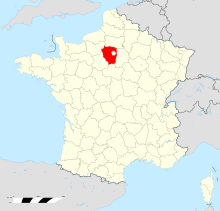| This article needs additional citations for verification. Please help improve this article by adding citations to reliable sources. Unsourced material may be challenged and removed. Find sources: "Seine-et-Oise" – news · newspapers · books · scholar · JSTOR (October 2010) (Learn how and when to remove this message) |


Seine-et-Oise (French pronunciation: [sɛn‿e waz]) is a former department of France, which encompassed the western, northern and southern parts of the metropolitan area of Paris. Its prefecture was Versailles and its administrative number was 78. Seine-et-Oise was disbanded in 1968 as part of the reorganisation of the departments of the Paris metropolitan area. The newly created Yvelines department inherited the 78 number.
General characteristics
Seine-et-Oise was created on 4 March 1790 during the French Revolution. Its name comes from the two main rivers (Seine River and Oise River) flowing through it. It completely surrounded the Seine department (which included Paris itself), although it was at its narrowest just east of Seine between that department and the Seine-et-Marne department, which still exists today.
At the time of its abolition in 1968, Seine-et-Oise consisted of 688 suburban and rural communes. It had an area of 5,658 km (2,184 sq. miles). The division of Seine-et-Oise into arrondissements changed many times; the final change aligned arrondissement borders with those of its successor departments. For the last two decades of its existence before the preparations for its dissolution, it has five arrondissements: Corbeil, Mantes, Pontoise, Le Raincy, Rambouillet, and Versailles. At the moment of its dissolution it had ten arrondissements: Étampes, Évry, and Palaiseau, designated to form the Essonne department; Argenteuil, Montmorency, and Pontoise, designated to form the Val-d'Oise department; and Mantes, Rambouillet, Saint-Germain-en-Laye, and Versailles, designated to form the Yvelines department.
Abolition

At the first French census in 1801, Seine-et-Oise had 421,535 inhabitants. With the growth of the Paris suburbs, the population of Seine-et-Oise increased markedly, and by 1968 it had reached 2,943,350 inhabitants. It was judged that Seine-et-Oise, along with the Seine department, had become too large and ungovernable. On 1 January 1968, it was split into three smaller departments: Yvelines, Val-d'Oise, and Essonne. A small part of Seine-et-Oise was also merged with parts of the Seine department (also disbanded on the same date) to create the three new departments of Hauts-de-Seine, Val-de-Marne, and Seine-Saint-Denis.
In detail, the splitting up of the Seine-et-Oise department was carried out thus: 262 communes in the central part of the department became the Yvelines department, with Versailles as the prefecture. The official number 78, which was used for Seine-et-Oise, was given to the new Yvelines department, which is the largest of the three (40% of the area of Seine-et-Oise). There were 198 communes in the south of Seine-et-Oise (32% of the area of Seine-et-Oise) that became part of the Essonne department, and the official number 91 was assigned to this department, a number that had been previously used for the Alger department in French Algeria). There were 184 communes in the north of Seine-et-Oise (22% of the area of Seine-et-Oise) that became part of the Val-d'Oise department, and the official number 95 was assigned to this department, a number that had never been used.
Of the remaining 6% of Seine-et-Oise, 18 communes were grouped with 29 communes of the Seine department to create the Val-de-Marne department, 16 communes of Seine-et-Oise were grouped with 24 communes of the Seine department to create the Seine-Saint-Denis department, and the last 9 communes of Seine-et-Oise were grouped with 27 communes of the Seine department to create the Hauts-de-Seine department.
Thus, Yvelines, Val-d'Oise, and Essonne together are smaller than the former Seine-et-Oise department (5,658 km for the Seine-et-Oise department vs. 5,334 km for the three departments).
Grande couronne
The three departments of Yvelines, Essonne, and Val-d'Oise, plus the Seine-et-Marne department, are altogether known in France as the grande couronne ('large crown' or 'large wreath', as opposed to the 'small wreath' of suburbs closer to Paris).
Population
At the 1999 French census, the population of the former department of Seine-et-Oise was 4,554,426 inhabitants, its highest figure ever, as people relocated more and more from the center to the distant suburbs of the metropolitan area of Paris. Of the new departments created in 1968 from Seine-et-Oise, Yvelines was the most populous in 1999 with 1,354,304 residents. Seine-Saint-Denis and Hauts-de-Seine are more populous than Yvelines, but only a small part of their territory is made up of the former Seine-et-Oise.
See also
Notes
- Those parts of Seine-et-Oise designated to form the Petite couronne departments of Hauts-de-Seine, Val-de-Marne, and Seine-Saint-Denis were each included in a canton, provisionally assigned to the arrondissements designated to form Yvelines, Essonne, and Val-d'Oise respectively, until the day of Seine-et-Oise's dissolution
References
- "En 1964 naissaient les nouveaux départements de la petite couronne", La Dépêche (in French), 2014-07-10.
- ^ "Préfecture du département de Seine-et-Oise - Archives du musée d'Archéologie nationale".
- "Urban characteristics of Paris, Petite Couronne, and Grande Couronne,... | Download Scientific Diagram".
48°48′N 2°08′E / 48.800°N 2.133°E / 48.800; 2.133
Categories: